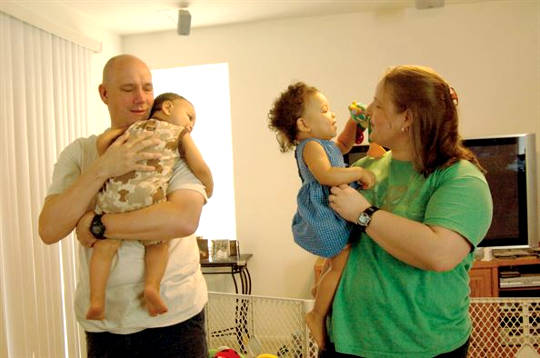
It is enormously helpful to meditate at the same time every day if our schedule will allow it. For many of us, family competes for our meditation time. This is perhaps one of our greatest struggles: how can we find time for ourselves without taking it from them?
To this there is no easy answer, but what is especially important is the centrality of kindness. Hard and fast rules cannot be applied, but that need not be a problem as mindfulness is not about being perfect but about being present.
Martin Wells, who has been studying meditation for over 30 years, describes being mindfully present with whatever is happening, even when a daily sitting practice is proving hard to establish:
We’ve had someone in this last training year who has got young children and he asks, “Where do I find the necessary space?” Without wanting to be too fixed about it, I do recommend people have a time and a place to practice, because I think both those things are helpful. However, the time and the place are simply anchors and ways of us keeping a commitment, not something to get attached to. With situations like his, I think it’s important to think about other ways to practice being mindful. For instance, using the kids as his practice— realizing that the disturbance that they bring him doesn’t disturb anything on the level of his fundamental stillness or the peace that is inherent in him. So in a way, practice can be heightened by those sorts of challenges and what appears as disturbance can serve as a reminder to the background stillness.
The Perfect Situation?
The issue of not striving for a perfect situation in which to practice is an important one. Finding a place that is perfectly silent and entirely undisturbed is almost impossible, but more importantly—within limits—it is not even desirable, as it would not help us cultivate the ability to be mindfully present and accepting of whatever our situation and circumstances are. Good or bad.
Martin talks about this in the context of a family, reminding us that silence is not so much a quality of our environment as a place in ourselves that is not in reaction to what is going on in our own minds or the place we physically inhabit:
There might be ways—practical ways, again—to deal with finding a time and place to practice: When do the kids get up? When are they in bed? Are those the times to more formally practice? Or put some headphones on and let your wife deal with bath time. There are ways round it usually! But one of the things that often comes up . . . is people assume that to meditate they need to have silence—they need to block out the world rather than embrace the world and its distractions and noises. But distractions and noises can be just like a bell ringing. Its sound alerts us to the silence when it stops. And that’s a useful shift for people to make because sometimes people are caught with that almost impossible struggle to create a space, or create silence, and of course it doesn’t need to be created—it’s there already. Unchanging.
The Perfect Place?
Besides finding a time to meditate, we also need to find a place. Finding a place to sit when we practice mindfulness is important, as the place itself will come to support our practice both by association and by the special atmosphere that builds up where we meditate.
The Buddhist texts recommend that we take ourselves off to the forest and sit beneath a tree, on a cushion of grass, to start meditating. Nowadays our largely urban existence makes such a setting improbable, but we can still usually find a corner in our home—or even our car—that can be the place we routinely sit in.
~ Ann sits on the sofa in her sitting room because it has lots of light and space.
~ Ben says that although he has a big house where he could make a special meditation room, he prefers his kitchen.
~ Tess has her special place of refuge that has to double as a guest room and TV room for teenagers.
©2015 by Nigel Wellings.
Reprinted with permission of the publisher,
The Penguin Group/Perigee. www.penguin.com
Article Source
 Why Can't I Meditate?: How to Get Your Mindfulness Practice on Track
Why Can't I Meditate?: How to Get Your Mindfulness Practice on Track
by Nigel Wellings.
Click here for more info and/or to order this book.
About the Author
 NIGEL WELLINGS is a psychoanalytic psychotherapist and author who works within a broadly contemplative perspective. He first attempted to practice mindfulness in his late teens and has been engaged with the relationship between psychotherapy and meditation for the last forty years. He lives in Bath and is a teacher on the Bath and Bristol Mindfulness Courses. Visit his website http://www.mindfulness-psychotherapy.co.uk/
NIGEL WELLINGS is a psychoanalytic psychotherapist and author who works within a broadly contemplative perspective. He first attempted to practice mindfulness in his late teens and has been engaged with the relationship between psychotherapy and meditation for the last forty years. He lives in Bath and is a teacher on the Bath and Bristol Mindfulness Courses. Visit his website http://www.mindfulness-psychotherapy.co.uk/




























